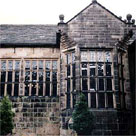Hoghton Tower

Base layers
Data layers

Other Images
Venue Type & Location
Site Name: Hoghton Tower
Location: near Preston
County: Lancashire
Location Type: Town - near town at determined location
Performance Spaces
Overview
Built in a commanding position on the Hoghton Hill escarpment in the SW of the Pendle range, overlooking the River Darwen to the E. Situated 6 miles E of Preston on the old route to Blackburn.
Approached from the W along a tree-lined avenue, with formal gardens to the E, S and SW of the house. Woodland to the N and E.
An imposing sandstone house of conservative mid-16th c. design. 2 quadrangular courtyards with the outer court functioning to house servants while the inner court contained the banqueting hall and living quarters for the family. The house consists of 2 storeys throughout except the SE wing and S side of the outer courtyard where it has 3 storeys.
The outer quadrangle measures 130' on its E-W axis and 108' on the N-S axis. The inner quadrangle is significantly smaller measuring 70' square.
The Great Hall is located in the N side of the inner quadrangle. Access is via a set of semi-circular exterior stairs in the courtyard.
Performance History
No surviving household accounts have been located but the royal visit by James I in 1617 is known from other sources including Nicholas Assheton's journal. There are no known records of touring professional entertainers at Hoghton although it was well situated to attract performers.
Current Status
Hoghton Tower remains in the hands of the Hoghton family as their principal residence. At specified times of year parts of the house are open to the public.
History of the Venue
An earlier building on this site had been occupied by the Hoghton family since the early 14th c.
1562 Thomas Hoghton commenced rebuilding. Much of the present house dates from this time.
1642 The family was royalist in the civil conflict. Fortified portions of the house were destroyed at this time by Cromwell's forces, notably the central tower over the gatehouse dividing the 2 courtyards.
ca. 1700 Additions, especially S wing of lower courtyard.
ca. 1710 The Hoghton family moved to Walton Hall, Walton le Dale, and Hoghton Tower fell into disrepair.
1862 Restoration of the house was undertaken by Sir Henry de Hoghton with architect Edward Paley.
1901 Completed by Sir James de Hoghton with architect R.D. Oliver. This work is considered to have been carefully done with regard to preserving the building's original character.
Record Source
REED Lanc 146, 153--6
Patrons who owned this venue
| Name | Dates | Titles |
|---|---|---|
| Hoghton, Richard | 1570-1630 | Knight , Knight Baronet |
Bibliographic Sources
-
Garner, Thomas, and Arthur Stratton. The Domestic Architecture of England during the Tudor Period. 2 vols. London: Batsford, 1911.
-
George, David, ed. Lancashire. Records of Early English Drama (REED). Toronto, Buffalo, London: U of Toronto P, 1991.
-
'Hoghton Tower, Lancashire, the Seat of Sir James de Hoghton.' Country Life 17 (11 and 18 Feb. 1905): 198–206, 234–41.
-
Miller, George C. Hoghton Tower: the History of the Manor, the Hereditary Lords and the Ancient Manor-house of Hoghton in Lancashire. Preston: Guardian P, 1948.
-
Rimmer, Alfred. Ancient Halls of Lancashire. np: npub, 1852.
-
Taylor, Henry. Old Halls in Lancashire and Cheshire. Manchester: J.E. Cornish, 1884.










